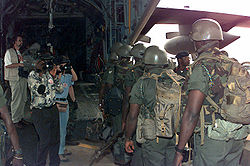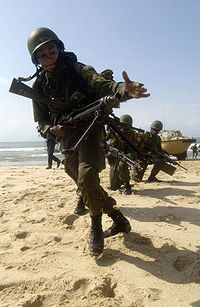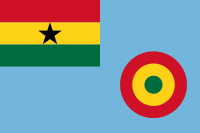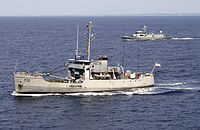- Ghana Armed Forces
-
Military of Ghana Military manpower Military age 18 years of age(2002) Availability males age 15-49: 5,045,355 (2002 est.) Fit for military service males age 15-49: 5,045,355 (2002 est.) Reaching military age annually males: 213,237 (2002 est.) Military expenditures Percent of GDP 2.0 (FY10) The Ghanaian military is one of the most professional and up-to-date militaries in West Africa. Ghana's modern military was formed after independence in 1957. The Ghanaian military is primarily composed of the Army, which forms the pre-eminent service, more important that the Air force or navy. From 1966 the military was extensively involved in politics, mounting several coups; see History of Ghana (1966-1979).
Ghana's nominal chief military commander is the President of The Republic, with various generals and other commanders leading troops in the field. The Ministry of Defence and Central Defence Headquarters are both located in Accra. Accra, in the British colony of the Gold Coast, was also the location of the British Army’s Headquarters West Africa Command which remained there until its disbandment in 1956.
Contents
Army
The Ghana Army is structured as follows:
- The Northern Command with headquarters in Kumasi and the Southern Command with headquarters in Accra. In March 2000 these two commands were formed after a restructuring of the existing brigades: 1st Infantry Brigade (HQ in Teshie), 2nd Infantry Brigade (HQ in Kumasi)and Support Services Brigade (HQ in Burma Camp).[1]
- 6 Infantry Battalions of the Ghana Regiment. 3rd Battalion of Infantry, 4th Battalion of Infantry and 5th Battalion of Infantry in the Northern Command, 1st Battalion of Infantry, 2nd Battalion of Infantry and 5th Battalion of Infantry in the Southern Command.
- 2 Airborne companies attached to Northern Command; Airborne Force
- 1 Battalion of the in charge of state security ;64 Infantry Regiment (formerly known as President's Own Guard Regiment)
- 1 Training Battalion
- 1 Staff College
- 2 Armoured reconnaissance squadrons of the Reconnaissance Armoured Regiment
- 1 Signals Regiment
- 2 Engineer Regiments (48 Engineer Regiment and 49 Engineer Regiment)
- 1 artillery regiment (66 Artillery Regiment)
- 1 Logistics Group.
The Ghanaian Army relies on a mix of modern military technology and older varieties. While modern M16s and equipment are standard issue, much of the secondary equipment used by the Ghanaian military is generally older than that used in Western military forces, and Ghanaian troops frequently rely on British, Brazilian, Swiss, Swedish, Israeli, and Finnish weaponry.
Air Force
The Ghana Air Force is headquartered in Burma camp Accra, and operates from bases in Accra (main transport base) Tamale (combat and training base), Takoradi (training base), and Kumasi (support base). The Air Force's stated mission is to perform counterinsurgency operations within Ghana and to provide logistical support to the army.[citation needed] Like the army, the air force suffers from frequent shortages of spare parts and poor maintenance of equipment. The Ghanian air force has the following but not limited to aircrafts:
- Aermacchi MB-326
- Aero L-39 Albatros
- Aerospatiale Alouette III
- Agusta A109
- Bell 412
- Britten-Norman Islander
- Cessna 172 Skyhawk
- Fokker F27 Friendship
- Fokker F28 Fellowship
- Hongdu JL-8
- Mil Mi-2
- Mil Mi-17
The Ghana Air Force was interested in ordering 4 C-27J Spartans. They changed mid-purchase and ordered 2 Airbus C295 aircraft.
The Ghana Navy provides defence of Ghana and its territorial waters, fishery protection, and internal security on Lake Volta. It is also tasked with resupplying Ghanian peacekeepers in West Africa, fighting maritime criminal activities such as Piracy, disaster and humanitarian relief operations, and evacuation of Ghanian citizens and other nationals from troubled spots. In 1994 the navy was re-organized into an Eastern command, with headquarters at Tema, and a Western command, with headquarters at Sekondi-Takoradi.
In the late 1980s and early 1990s, due to financial constraints and a lack of serviceable equipment, the navy temporarily shrank from about 1,200 personnel to around 850, but the numbers soon rose. By 2010, the navy had over 2000 personnel.
Other
Paramilitary forces deal with preventing and controlling civil disturbances and insurrection. The Palace Guard, a small elite Presidential guard, provides security for the President.
Peacekeeping
 Ghanaian soldiers boarding a USAF C-130 Hercules at Kotoka International Airport to take part in an ECOMOG mission in Liberia
Ghanaian soldiers boarding a USAF C-130 Hercules at Kotoka International Airport to take part in an ECOMOG mission in Liberia
The Ghanaian military is recognised as one of the most professional and up-to-date armed forces in West Africa, and as Ghana itself is a peaceful nation, enjoying stable relations with its neighbours in West Africa, Ghana is free to commit a large proportion of its armed forces to international peacekeeping operations. Such operations are mainly conducted in Africa, while large Ghanaian forces are frequently posted across the world as elements of United Nations peacekeeping forces. The United Nations has often relied on Ghanaian forces to conduct peacekeeping operations, in countries as diverse as Rwanda, Kosovo, and Lebanon. Currently, Ghanaian forces are posted to United Nations peacekeeping missions as follows:
- MONUC (Democratic Republic of Congo) - 464
- UNMIL (Liberia) - 852
- UNAMSIL (Sierra Leone) - 782
- UNIFIL (Lebanon) - 651
Miscellaneous
Ghanaian statutory law officially prohibits civilians and foreign nationals from wearing military apparel such as camouflage clothing, or clothing which resembles military dress. Officially, fines and/or short prison sentences can be passed against civilians seen in military dress in public. However, this regulation is not enforced, and Ghanaian civilians are able to wear military-style apparel (such as civilian clothes in a camouflage finish) without any difficulties from law enforcement. In addition, Ghanaian law prohibits the photographing of police or military personnel and vehicles while on duty, strategic sites such as Kotoka International Airport when in use, and the seat of the Ghanaian government, Osu Castle.
See also
External links
- ^ Africa South of the Sahara 2003, 32nd Edition
 Ghana topics
Ghana topics 
Government and politics Corruption · Elections · Flag · Foreign relations · Governments · Ministries and Agencies · Ministers · Parliament · Political parties · President · LGBT rights · Immigration to GhanaGeography Economy Health Ministry of Health · Ghana Health Service · NHIS · Christian Health Association of Ghana · Eyecare · Optometry · OpticianReligion Law Judiciary · Human rightsSports Culture and society Other topics Communications · Economy · History · Military · Transport · List of Ghanaians · Water supply and sanitation Years in Ghana ·
Years in Ghana ·  Ghana templates ·
Ghana templates ·  Economy of Ghana
Economy of GhanaMilitary of Ghana Military of Africa Sovereign
states- Algeria
- Angola
- Benin
- Botswana
- Burkina Faso
- Burundi
- Cameroon
- Cape Verde
- Central African Republic
- Chad
- Comoros
- Democratic Republic of the Congo
- Republic of the Congo
- Côte d'Ivoire (Ivory Coast)
- Djibouti
- Egypt
- Equatorial Guinea
- Eritrea
- Ethiopia
- Gabon
- The Gambia
- Ghana
- Guinea
- Guinea-Bissau
- Kenya
- Lesotho
- Liberia
- Libya
- Madagascar
- Malawi
- Mali
- Mauritania
- Mauritius
- Morocco
- Mozambique
- Namibia
- Niger
- Nigeria
- Rwanda
- São Tomé and Príncipe
- Senegal
- Seychelles
- Sierra Leone
- Somalia
- South Africa
- South Sudan
- Sudan
- Swaziland
- Tanzania
- Togo
- Tunisia
- Uganda
- Zambia
- Zimbabwe
States with limited
recognition- Sahrawi Arab Democratic Republic
- Somaliland
Dependencies and
other territories- Canary Islands / Ceuta / Melilla / Plazas de soberanía (Spain)
- Madeira (Portugal)
- Mayotte / Réunion (France)
- Saint Helena / Ascension Island / Tristan da Cunha (United Kingdom)
- Western Sahara
Categories:
Wikimedia Foundation. 2010.



